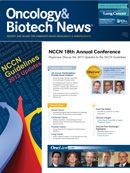Publication
Article
Adding Cetuximab to Chemotherapy Increases Resection Rates of Colorectal Liver Metastases and Extends Survival
Author(s):
The addition of cetuximab to chemotherapy as first-line treatment of KRAS wild-type unresectable colorectal liver metastases resulted in a higher rate of resection and longer survival than chemotherapy alone
Jianmin Xu, MD, PhD
The addition of cetuximab (Erbitux) to chemotherapy as first-line treatment of KRAS wild-type unresectable colorectal liver metastases (CLMs) resulted in a higher rate of resection and longer survival than chemotherapy alone, according to findings of a study from researchers in the People’s Republic of China.
“Our study suggests that in Chinese patients adding cetuximab to chemotherapy may effectively reduce tumor burden and increase the possibility of surgically removing liver metastases, improving survival and quality of life, ” said senior study author Jianmin Xu, MD, PhD, a surgeon at the Zhongshan Hospital in China. “While our study evaluated only Chinese patients, these findings may also be relevant for patients in North America and Europe.”
Overall survival (OS) in patients with CLMs is significantly improved in patients whose tumors are completely removed; however, fewer than 20% of patients with CLMs are considered candidates for the surgery. Even with administration of neoadjuvant chemotherapy, the rate of liver resection in these patients has been low.
In the study, 116 patients with wild-type KRAS colorectal adenocarcinoma with resected primary tumors but unresectable secondary liver metastases were deemed evaluable from the total intent-to-treat population of 138 patients. Patients had been randomly assigned to either FOLFIRI (fluorouracil, leucovorin, and irinotecan) or mFOLFOX6 (modified fluorouracil, leucovorin, and oxaliplatin) plus cetuximab (n = 59) or one of the two chemotherapy regimens alone (n = 57).
Treatment began 2 to 4 weeks after primary surgery and continued until the patient was considered a candidate for CLM resection based on tumor response, or until treatment was discontinued due to progression or toxicity. The median number of treatment cycles prior to surgery was six. The study’s primary endpoint was determination of CLM resectability; tumor response, OS, and progressionfree survival (PFS) were secondary endpoints.
In the cetuximab arm, 20 patients were considered eligible for radical CLM surgery, versus 9 patients in the chemotherapy-only group. After attrition due to refusal of surgery or inability to resect at exploration, 18 patients in the cetuximab group and 5 in the chemotherapy-alone cohort had surgical resection of their CLM, a significant difference (odds ratio, 4.37; P <.01).
Importantly, the researchers noted, the decision to offer secondary liver resection was made by liver surgeons. In previous studies, this determination was made mostly by general oncologists without input from liver surgeons.
For the other endpoints, 3-year OS for the cetuximab group versus the chemotherapy-only group was 41% and 18%, respectively, with a median survival time (MST) of 30.9 months versus 21 months (hazard ratio [HR] = 0.54; P = .013); median PFS was 10.2 and 5.8 months, respectively (HR = 0.60; P = .004). Objective response was also better in the cetuximab arm: 57.1% versus 29.4% in the chemotherapy-alone group.
Surgical resection was beneficial to patients in both cohorts. Those in the cetuximab group who underwent CLM resection had an MST of 46.4 months, compared with 25.7 months for those who did not have surgery (P = .01); in the chemotherapy-alone group, MST was 36 and 19.6 months, respectively. No statistically significant differences in OS or PFS were reported between the two groups among patients who had the liver resection, however.
Toxicity was mild in both arms. A higher incidence of a reversible, acne-like rash was seen in the cetuximab arm; patients experiencing grade 2 and 3 skin reactions showed greater treatment benefit than those with 0-1 skin reactions. No significant differences in grades 3 and 4 adverse events were found between the groups.
Limitations of the study cited by the authors included a small study population and a relatively short follow-up time, with the 5-year OS rate not yet reached.
Ye LC, Liu TS, Ren L, et al. Randomized controlled trial of cetuximab plus chemotherapy for patients with KRAS wild-type unresectable colorectal liver-limited metastases [published online ahead of print April 8, 2013]. J Clin Oncol. doi:10.1200/JCO.2012.44.8308.










